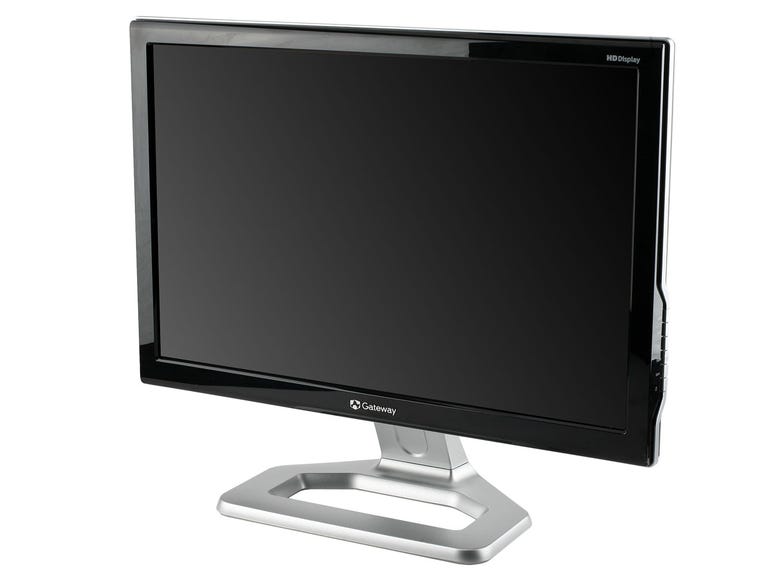The 19-inch Gateway HD1900 is available online for as cheap as $150. For that price, the monitor provides VGA and DVI connections and supports HDCP. The monitor delivers great performance--both games and movies have vibrant colors and deep blacks. The Gateway includes a tilt feature, but forgoes adding a pivoting, rotation, or screen height adjustment option. The Lenovo ThinkVision 1940p includes all of these ergonomic options, but is about $130 more. The "="">Samsung SyncMaster 953BW is about on par with the Gateway's performance and limited feature set, but the Samsung costs about $20 more. So if you're in the market for a low price 19-inch monitor and have no need of ergonomic features the Gateway HD1900 is a sound choice.
The Good
The Bad
The Bottom Line
Design and features
Aesthetically speaking, the most noticeable feature of the Gateway HD1900 is its glossy black bezel, which measures 0.75 inch on the sides and top and 1 inch on the bottom. A thin gray overlay runs along the outside of the bezel that adds about 2 centimeters to the display's overall width of 18 inches. Compared with the 17.25-inch wide Lenovo ThinkVision 1940p and 17.5-inch Samsung SyncMaster 953BW, the Gateway takes up the most desktop space. The panel's depth measures about 1.25 inches, but its backside and ventilation system make for a total thickness of 2.5 inches.
Ergonomic options are limited, unfortunately. You'll only find options for tilting the screen back about 15 degrees and forward about 5 degrees. There are no screen height adjustments, rotation, or pivoting options. The bottom of the screen sits nearly 3 inches above the desktop, so unless you enjoy a sore neck, you'll want to prop it up at least another 3 inches. The footstand measures about 9.5 inches wide and is 6.5 inches deep with a somewhat pentagon shape. When knocked from the sides, the display wobbles more than we'd like.
The connection options are also limited, including only VGA and DVI. There is no HDMI connection, but the DVI connection has HDCP support for playing high-definition content.
The onscreen display buttons are located on the lower right side of the panel. There are five buttons with each button measuring a short 0.5 inch in length. The buttons are labeled clearly, but you'll have to turn the display to the left to see them. The OSD options include the usual brightness, contrast, and color, as well as a Theme button, which lets you quickly switch between different modes such as Game, Web, and Movie. Unfortunately, navigating the OSD can be frustrating as there are no individual controls for up or down. Instead, the Auto and Brightness buttons double as the up and down.
Manufacturer's specifications:
Resolution: 1,440x900
Pixel-response rate: 5ms
Contrast ratio: 1,000:1
Brightness: 300cd/m2
Connectivity: DVI, VGA
HDCP compliant? Yes
Included video cables? VGA
Performance
We tested the Gateway HD1900 with its DVI connection. The display posted a composite score of 86 on CNET Labs' DisplayMate-based performance tests compared with a score of 84 for the 19-inch Samsung SyncMaster 953BW. The two displays exhibited similar performance in most of the DisplayMate test screens, but the Gateway scored slightly better in color and grayscale tests with color that is more accurate and less color tracking errors when displaying the grayscale.
The Gateway posted a brightness score of 289 per square meters (cd/m2), according to our test, which is just less than the 300 cd/m2 maximum score claimed by the Gateway display. The Samsung SyncMaster 953BW was right on its heels with a 285 cd/m2 brightness rating. When viewing a completely dark screen in a dark room, the Gateway exhibited more backlight bleed through than the Samsung but we didn't see any evidence of bleeding in normal room lighting while the monitor displayed a typical screen.
World of Warcraft, as usual, looked great on the HD1900 and the SyncMaster 953BW. On both monitors, the game exuded vibrant colors and the polygonal characters looked full and three-dimensional.
When we watched the Superbit DVD version of Spiderman 2 on the Gateway display, we saw the same vibrant colors and no evidence of backlight bleeding. Overall, we felt as if the Gateway had deeper blacks than the Samsung SyncMaster 953BW, which makes it better suited for watching movies.
The optimal viewing angle for a monitor is usually directly in front, about a quarter of the screen's distance down from the top. At this angle, you're viewing the colors and gamma correction as they were intended. Most monitors are not made to be viewed at any other angle. Depending on their panel type, their picture quality at non-optimal angles varies. Most monitors use TN panels, which get overly bright or overly dark in parts of the screen when viewed from non-optimal angles. Since both the Gateway and the Samsung use TN panels and when each is viewed from a non-optimal angle, the screen appears to darken, and we were unable to see the picture details when playing a game. As long as it's being viewed from the optimal angle, however, we had no problems.
| Gateway HD1900 | Average watts per hour |
| On (Default Luminance) | 30.86 |
| On (Max Luminance) | 33.82 |
| On (Min Luminance) | 16.55 |
| Sleep | 0.59 |
| Calibrated (200 cd/m2) | 31.43 |
| Score | Good |
| Annual energy cost (@$0.1135/kWh) | $9.61 |
(Longer bars indicate better performance)
(Longer bars indicate better performance)
(Longer bars indicate better performance)
Find out more about how we test LCD monitors.
Service and support
The monitor includes a one-year limited warranty that covers parts and labor. Gateway backs this up with 24-7 toll-free phone technical support as well as technical support via e-mail.



